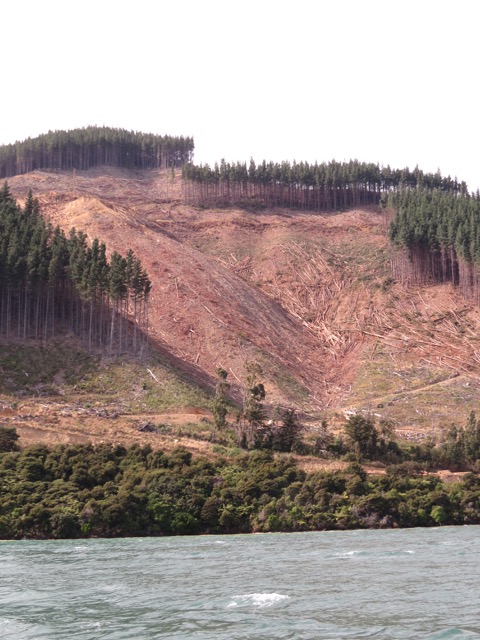by Ben Hope
The Marlborough Sounds is facing a crisis due to accelerated runoff and deposition of silt into its bays.
The environmental degradation and smothering of the inner marine ecosystems of the Sounds has occurred because of extensive planting in commercial exotic plantations in past decades and in recent years the harvesting practice clear felling of hillsides.
The ill effects are further upstream in the river valleys where freshwater aquatic ecosystems and trout fishing rivers suffer from siltation and forestry debris.
Yet the forest industry seems in denial. An advertisement by New Zealand Wood one years ago, extolled the environmental benefits of “plantation forestry” claiming they “stabilise hillsides, protect soil health, purify water, regulate its flow and help prevent flooding.”
How do the claims stack up?
Well the term New Zealand Wood is a misnomer as New Zealand pine forests are largely foreign owned. In 2010 Keith Woodford Professor of Farm Management and Agribusiness Lincoln University wrote that about 72% of pine forests were foreign owned, with United States companies owning about 35% and Asian companies about 12%. More recent data is incomplete but foreign ownership appears to have further increased.
Environmentally, pine forests do stabilise hillsides at least for 25 years until clear felling at harvest time exposes whole catchments to any rains and subsequent runoff of silt and debris into streams, rivers and ultimately estuarine areas. But claims of enhancement of soil health, water purity and regulation of flow are all far fetched.
Increased Acidity
In the UK information from studies in southwest Scotland point to a strong relationship between salmon fishery catch figures falling alarmingly since 1960 about the time pine forests were extensively planted. Sources point to one detrimental aspect being acidification that occurs with monocultures of pines. The pH level (degree of acidity) is important to both bottom fauna and subsequently trout. If the pH drops below 5.5 (increased acidity) then long term damage to the fishery, both native and trout, occurs.
The UK’s “Trout and Salmon” magazine said “conifers are highly efficient at taking and filtering acidity so that it flows through the soil and water beneath them. Thus acidic loading increases as the trees grow.”
Pine forests do regulate water flow but in actual fact adversely by reducing normal natural water runoff that occurs with native vegetation. A pine tree reportedly uses much more water than native trees. Runoff from a pine forest is understandably much quicker than with native vegetation, the latter acting like a ’sponge’ and holding water thus releasing it slowly.
Water from a pine forest with a “bare” pine needle forest floor has quicker runoff compared to a typical native forest area with shade-loving undergrowth. In a few words, native forest has a higher water retention factor leading to natural, more consistent stream flows.
Wilding pines seeded from exotic plantations, have become a major problem particularly in the South Island’s high country.
Anecdotal evidence points to streams much reduced in flow once monocultures of pines have been established. For example, long-time residents near pine plantations have observed the same diminished flow in creeks after extensive monocultures of pine forests are established.
The adverse effects begin from day one when at planting time, native bush is usually cleared, often by burning. Currently sheep and beef farms are being converted to pine forests for the express purpose of carbon trading.
The original merino sheep stations were “holistically” farmed with stable ecosystems.
If the price of carbon falls from its present high of $76 a tonne, the forests are likely to be logged.
Clear Felling NZ
Twenty five or thirty years later at harvesting time, the practice of clear felling pines exposes often steep hill country to heavy rains and runoff of silt and debris. In some European countries, felling is in done in two cuts perhaps 12 months apart, along contours thus reducing runoff. The United States have enlightened forest felling regimes instead of total clear felling of hillsides.
One comment from a New Zealander who regularly visited the US – “I noticed when flying to Alaska each year is logging over Washington State and Oregon forests is clearly done on a patchwork quilt basis – not entire hillsides and mountains all planted at the same time and then logged at the same time.”
Clearly claims by the vested interest forestry bodies are open to challenge.
Forest monocultures are to be avoided by:-
(a) Better zoning by councils to prevent forestry monocultures
(b) Better harvesting regimes as practised in Europe should be implemented
(c) Local council zoning of land should avoid extensive commercial forestry
monocultures.
(d) Buffer zones of 50 metres of native vegetation along all streams
(e) Stricter rules to avoid planting on steep hillsides.

Clear felling of pines, Marlborough Sounds. Siltation is a major problem from run-off from logged areas.

Pine trees en masse deplete groundwater levels and creeks and streams dry up. Aquifers are lessened and lowered.
Water is precious more and more today.